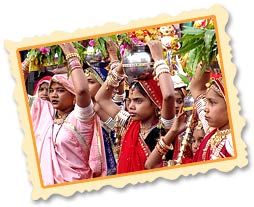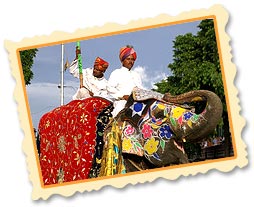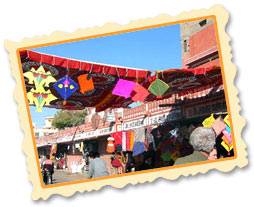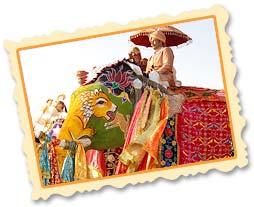Gangaur Festival
| Time of Celebration: | March-April |
| Place: | Rajasthan, Some Parts of Gujarat and Madhya Pradesh |
| Duration of Celebration: | 18 Days |
 Gangaur
is one of the most vivid festivals rejoiced with great enthusiasm and
happiness all over the Indian state of Rajasthan. In the word Gangaur,
'Gan' is the synonym for Lord Shiva whereas 'Gaur' stands for Gauri or
Goddess Parvati. But mainly, this festival is held in the honour of
Goddess Parvati as she is regarded as the epitome of marital love,
strength, courage, power and excellence. During the festivities, married
women worship Goddess Parvati for the long life, well being and wealth
of their husbands while the girls pray for getting a smart and an
understanding life partner. The festival is rejoiced in the month of
Chaitra, the first month of the Hindu calendar and falls in between
March and April, according to Gregorian calendar. It begins on the very
first day Chaitra month, the day after Holi and is celebrated for 18
days. Also, it marks the end of winter season and the coming of spring
season.
Gangaur
is one of the most vivid festivals rejoiced with great enthusiasm and
happiness all over the Indian state of Rajasthan. In the word Gangaur,
'Gan' is the synonym for Lord Shiva whereas 'Gaur' stands for Gauri or
Goddess Parvati. But mainly, this festival is held in the honour of
Goddess Parvati as she is regarded as the epitome of marital love,
strength, courage, power and excellence. During the festivities, married
women worship Goddess Parvati for the long life, well being and wealth
of their husbands while the girls pray for getting a smart and an
understanding life partner. The festival is rejoiced in the month of
Chaitra, the first month of the Hindu calendar and falls in between
March and April, according to Gregorian calendar. It begins on the very
first day Chaitra month, the day after Holi and is celebrated for 18
days. Also, it marks the end of winter season and the coming of spring
season.Women and girls observe fast during this festive time and eat only once in a day. Images of Gauri and Isar (Lord Shiva) are made with the clay and decorated very beautifully. On the other hand, in some of the Rajput families, images are made of wood every year before the festival they are painted by the famous painters who are called as 'Matherans'. The images which are made during this time do not have canopies. Women and girls, during the festival, wear new dresses, adorn themselves with jewellery and make designs on their palms and feet by applying mehandi (henna). On the 7th day evening girls carry 'ghudilas', which are earthen pots with many holes inside which a lamp is lit, on their heads. They sing songs of Gangaur and are given gifts in the form of money, ghee, sweets, jaggery, etc. by the elders of the family as a token of love.
This ritual goes on for 10 days and on the last day women and girls break the pots and throw the broken pieces into a well or a tank; the clay idols made by the married women are also immersed in water on the last day of the festival. A grand procession is held which starts from the Zanani-Deodhi of the City Palace which then goes through Tripolia Bazaar, Chhoti Chaupar, Gangauri Bazaar, Chaugan Stadium and finally converges near the Talkatora. This procession is headed by a colourful show of elephants, old palanquins, chariots, bullock carts and performance folk artistes. People irrespective of their caste and creed come to observe and to be a part of the procession.
Teej Festival
| Time of Celebration: | July-August |
| Celebrated: | In and around Rajasthan |
| Duration of Celebration: | One to two days |
 Jaipur,
the land that is always covered with the colours of fairs and
festivals, enchants whoever experiences the glory of fests. Festival of
every religion is celebrated with similar passion and beauty, be it
welcoming or bidding farewell to a season, praying for a healthy life of
the spouse or any other occasion for that matter. Each of these
festivals holds significant position in the lives of people of Jaipur.
One can not only feel the liveliness of people during these festivals,
but can even witness the rich culture of Rajasthan. And one such
festival is Teej, which falls in the monsoon months of July-August. On
this occasion, married women pray to Lord Shiva and Parvati to bless
them with happy and long married life. Celebrated in and around
Rajasthan this festival of swings welcomes monsoon. The swings are
decked with flowers and hung from trees, women dressed in green clothes
make merry and sing songs. This festival that symbolises growth
continues for two days, women observe fasts for the long life of their
husbands and men pray for good rain and crop.
Jaipur,
the land that is always covered with the colours of fairs and
festivals, enchants whoever experiences the glory of fests. Festival of
every religion is celebrated with similar passion and beauty, be it
welcoming or bidding farewell to a season, praying for a healthy life of
the spouse or any other occasion for that matter. Each of these
festivals holds significant position in the lives of people of Jaipur.
One can not only feel the liveliness of people during these festivals,
but can even witness the rich culture of Rajasthan. And one such
festival is Teej, which falls in the monsoon months of July-August. On
this occasion, married women pray to Lord Shiva and Parvati to bless
them with happy and long married life. Celebrated in and around
Rajasthan this festival of swings welcomes monsoon. The swings are
decked with flowers and hung from trees, women dressed in green clothes
make merry and sing songs. This festival that symbolises growth
continues for two days, women observe fasts for the long life of their
husbands and men pray for good rain and crop.Significance
According to mythology, it was the day when Goddess Parvati reunited with Lord Shiva after a long separation. It is said that whoever worships Parvati on this day, is fortunate enough to get his/her desires fulfilled by her blessings.
Rituals And Celebrations
On this day parents of married women send Sinjara to their daughters, which is a gift pack that includes bindi, vermilion, mehandi or henna, bangles, ghevar (a special Rajasthani sweet) and lahariya (a multi-coloured sari) as a symbol of their covertures. After accepting those gifts sent by her parents, the married ladies adorn themselves with henna, jewels, wear lahariya sari and take delight in the celebrations of this auspicious festival of Teej. Fairs are conducted on this festival; processions are taken out from Tripolia gate of this Pink City Jaipur. Passing through various markets, it ends at Chaugan Stadium. The idol of Goddess Teej (incarnation of Goddess Parvati) is decorated by the royal families of Jaipur, for the fair. Convoy of beautified elephants, horses and camels are made to walk before Goddess Teej's palanquin made of gold and silver. Various folk dances are performed to the tunes of folk songs during this rally.
Kite Festival Jaipur
| Time of Celebration: | 14th January, Makar Sankranti |
| Celebrated: | Jaipur, Rajasthan |
| Duration of Celebration: | One day |
 Jaipur
is the land of fairs and festivals. Always dipped in the colours of
festival, this place enchants anyone who experiences the glory of fests.
Festival of every religion is celebrated with same zeal and gusto. Each
festival has its importance, be it welcoming a season, bidding adieu to
a season, wishing long life and good health of the spouse, praise the
Lord, worship trees and animals in the form of God. These festivals are
integral part of the lives of people of Jaipur. One can not only feel
the liveliness of people during these festivals, but can even get a wide
exposure of culture of Rajasthan. These fairs and festival offer you
with a holistic view of the heritage and art of Rajasthan. A prominent
one out of the festivals of Rajasthan is the Kite Festival. Certainly,
it's a festival that is unique in its own way. The colourful kites
hovering over whole of Rajasthan brighten up the skies. This festival is
largely celebrated in Jaipur and Jodhpur. The kites-with-lights flown
add to the fancy of the festival. If you like kite flying, this is the
festival for you. How about visiting Jaipur during this festival? Know
more about this festival before you catch up with the delight of this
festival in Jaipur.
Jaipur
is the land of fairs and festivals. Always dipped in the colours of
festival, this place enchants anyone who experiences the glory of fests.
Festival of every religion is celebrated with same zeal and gusto. Each
festival has its importance, be it welcoming a season, bidding adieu to
a season, wishing long life and good health of the spouse, praise the
Lord, worship trees and animals in the form of God. These festivals are
integral part of the lives of people of Jaipur. One can not only feel
the liveliness of people during these festivals, but can even get a wide
exposure of culture of Rajasthan. These fairs and festival offer you
with a holistic view of the heritage and art of Rajasthan. A prominent
one out of the festivals of Rajasthan is the Kite Festival. Certainly,
it's a festival that is unique in its own way. The colourful kites
hovering over whole of Rajasthan brighten up the skies. This festival is
largely celebrated in Jaipur and Jodhpur. The kites-with-lights flown
add to the fancy of the festival. If you like kite flying, this is the
festival for you. How about visiting Jaipur during this festival? Know
more about this festival before you catch up with the delight of this
festival in Jaipur.Significance
Kite festival of Jaipur is observed on the day of Makar Sankranti or Uttarayan. Celebrated on 14th of January to mark the transition of the sun from dhanu rashi (Sagittarius) to makara rashi (Capricorn), the day is considered auspicious. It is said that Uttarayan or northward journey of the sun begins on the day of Makar Sankranti.
Rituals And Celebrations
The people of Jaipur, on this day take a holy dip in Galtaji, an important pilgrimage in Jaipur. They pray to sun god to bless them with good health, wealth and good crop. On this occasion, the pink city turns all colourful with the beautiful kites in the sky. Makar Sankranti is a government holiday in Jaipur, and it undoubtedly increases the pleasure of the festivities. Shopkeepers keep their shops shut, banks remain closed and everybody gets engrossed in kite flying on this day. Various kite flying competitions are also organised by numerous Kite Clubs in the month of January. State government even organises "International Kite Festival" in Jaipur for a stretch of three days wherein kite lovers from all over the world come and participate.
Food
The people of Jaipur celebrate this festival of Makar Sankranti with various sugary delights made of sesame seeds i.e. Til Ke Laddu, Gajak (famous Jaipur's Sesame Brittle), and Feeni (famous Jaipur sweet made of fibres).
Elephant Festival
| Time of Celebration: | February/March |
| Celebrated: | Jaipur |
| Duration of Celebration: | One Day |
 The
Elephant Festival is an annual festival which is held every year in the
Pink City, Jaipur. This matchless event is organised on the full moon
day of Phalgun Purnima which falls in the month of February/March. It is
celebrated on the day before the festivals of colours i.e. Holi. From
the ancient times, elephants have always been an important part of the
Indian society. The Elephant-headed God, Ganesha, believed to be the
remover of obstacles and foremost to all the gods, is revered and
devotedly worshipped in all the parts of India. They are also one of the
most important parts of religious events, marriage ceremonies,
processions, etc. and in the historic time, they were a significant part
of the battlefield.
The
Elephant Festival is an annual festival which is held every year in the
Pink City, Jaipur. This matchless event is organised on the full moon
day of Phalgun Purnima which falls in the month of February/March. It is
celebrated on the day before the festivals of colours i.e. Holi. From
the ancient times, elephants have always been an important part of the
Indian society. The Elephant-headed God, Ganesha, believed to be the
remover of obstacles and foremost to all the gods, is revered and
devotedly worshipped in all the parts of India. They are also one of the
most important parts of religious events, marriage ceremonies,
processions, etc. and in the historic time, they were a significant part
of the battlefield.For this festival, elephants are nicely groomed and clothed with colourful and embroidered velvets rugs and parasols and other heavy ornaments like huge elephant jewellery and anklets decked with bells. Intricate traditional Indian motifs are then painted on their bodies. Ear danglers and coloured brocade scarves adorn their ears and necks respectively. Their tusks too get jewelled up by adorning them with gold and silver bracelets and rings; while foreheads are beautified with royal looking head-plates. All this is done by their Mahouts (keepers/riders) after they are done giving their elephants a bath. Moreover, the Mahouts too bask into the sunshine of the festivities by perking up themselves in brocade jackets and royal turbans.
This festival begins with the huge and enthralling procession of the royal elephants painted with different shades of colours, embellished with heavy silver ornaments, and embroidered clothes. The elephants enter the ground with their mahouts, thumping to the sound of nagadas and loud blows of bankiya, a musical instrument. The participant elephants are all females. Elephant polo, Elephant race, the tug-of-war between Elephant and 19 men and women are the special features of this grand festival. There are live performances of dancers and musicians too. In addition to this, in the procession there are chariots, lancers on horses, camels, and palanquins. This festival is enjoyed by a huge number of crowds including the visitors from different parts of India as well as abroad. This festival, organised by Rajasthan Tourism and has now become an important part of its' annual events calendar. In previous time, this festival was held at the Chaugan Stadium located in the old city area of Jaipur but due to the increase in crowds and fame, its venue got changed in 2011 and has been shifted to Jaipur Polo Ground which is opposite to the Sawai Mansingh Stadium.
No comments:
Post a Comment